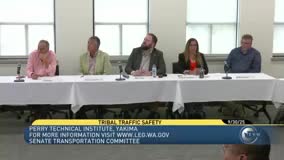Traffic Fatality Trends Among American Indian and Alaska Native People Examined in State Report
September 30, 2025 | Legislative Sessions, Washington
This article was created by AI summarizing key points discussed. AI makes mistakes, so for full details and context, please refer to the video of the full meeting. Please report any errors so we can fix them. Report an error »

The Washington Senate Transportation Committee meeting on September 30, 2025, highlighted a significant decline in traffic fatalities, marking a nearly 10 percent decrease in 2024 compared to the previous year. Despite this positive trend, the overall fatality rates remain alarmingly high, with recent years recording some of the highest numbers in three decades.
Key discussions centered on the demographic data of traffic fatalities, particularly among American Indian and Alaska Native populations. It was noted that a substantial portion of these fatalities involved individuals who were not driving at the time of the incident—53 percent were passengers, pedestrians, or bicyclists. This statistic underscores the need for broader safety measures beyond just focusing on drivers.
The meeting also revealed concerning trends regarding restraint use among victims. Nearly half of the fatalities among American Indian and Alaska Native individuals involved those who were unrestrained at the time of the crash. Young adults aged 21 to 35 were identified as the group least likely to use seatbelts, highlighting a critical area for targeted safety campaigns.
Behavioral risk factors contributing to fatal crashes were discussed, with alcohol impairment remaining a persistent issue. The number of alcohol-impaired drivers in 2024 matched figures from 2015, indicating stagnation in efforts to address this problem.
Additionally, the meeting addressed the geographic context of these fatalities. Most American Indian and Alaska Native individuals killed in traffic incidents were not on tribal lands, and in many cases, the majority of fatalities on tribal lands involved non-Native individuals. This data suggests a need for tailored safety initiatives that consider the unique circumstances of both tribal and non-tribal areas.
As the committee continues to analyze these trends, the focus remains on implementing effective strategies to reduce fatalities and improve road safety for all communities in Washington.
Key discussions centered on the demographic data of traffic fatalities, particularly among American Indian and Alaska Native populations. It was noted that a substantial portion of these fatalities involved individuals who were not driving at the time of the incident—53 percent were passengers, pedestrians, or bicyclists. This statistic underscores the need for broader safety measures beyond just focusing on drivers.
The meeting also revealed concerning trends regarding restraint use among victims. Nearly half of the fatalities among American Indian and Alaska Native individuals involved those who were unrestrained at the time of the crash. Young adults aged 21 to 35 were identified as the group least likely to use seatbelts, highlighting a critical area for targeted safety campaigns.
Behavioral risk factors contributing to fatal crashes were discussed, with alcohol impairment remaining a persistent issue. The number of alcohol-impaired drivers in 2024 matched figures from 2015, indicating stagnation in efforts to address this problem.
Additionally, the meeting addressed the geographic context of these fatalities. Most American Indian and Alaska Native individuals killed in traffic incidents were not on tribal lands, and in many cases, the majority of fatalities on tribal lands involved non-Native individuals. This data suggests a need for tailored safety initiatives that consider the unique circumstances of both tribal and non-tribal areas.
As the committee continues to analyze these trends, the focus remains on implementing effective strategies to reduce fatalities and improve road safety for all communities in Washington.
View full meeting
This article is based on a recent meeting—watch the full video and explore the complete transcript for deeper insights into the discussion.
View full meeting
